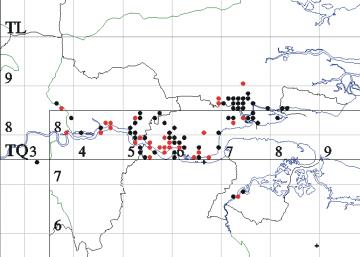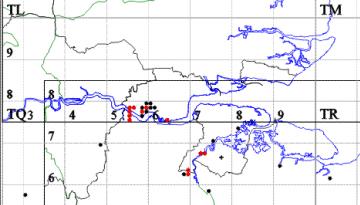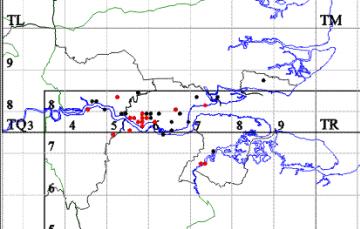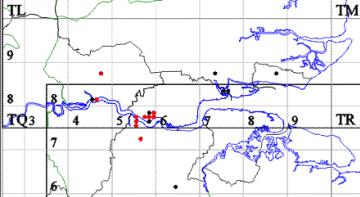threats to brownfield
in the Thames Gateway
by P.R. Harvey
Brownfield land that has been abandoned for years may develop high nature conservation importance (see brownfield importance for invertebrates). However the aim of the 'Thames Gateway' initiative, the government agency English Partnerships and the new Development Corporations is to deliver regeneration and economic development in the East Thames Corridor, which is viewed as a region of derelict, vacant and under used land. Even before this the old quarries and sand pits of Thurrock and north Kent had long been viewed as derelict wastelands, an eyesore and blight on the area. This has been a key force behind their development for massive housing and retail developments like €˜Chafford Hundred, €˜Lakeside and 'Bluewater' which have all followed on from the completion of the M25 and the more recent pressures to regenerate the region. The characteristic cycle of development which follows the construction of new motorways and by-pass roads is particularly prevalent elsewhere in Essex as well and the post-industrial or €˜brownfield sites in particular are under enormous threat (see destroyed sites for a few examples).
Despite its recognised national importance Mill Wood Pit in Thurrock was lost to housing development. Proposed local nature reserves at Warren and Lion Gorges (old chalk quarries) in Chafford Hundred do not contain the same important elements of habitat that were found at Mill Wood Pit where old habitats such as Mill Wood itself and calcareous grassland east of Mill Lane were adjacent to the more recent disturbed habitats produced by chalk quarrying and sand extraction. Much of Barking Levels have already been developed for housing and almost the whole of Barking PFA lagoons have been cleared and developed, planning permissions having been in place since the 1980s. Thamesmead on the Kent side of the Thames was an extensive area of habitat with an extremely important invertebrate fauna but it is nearly all lost to retail and associated housing development. Ferry Fields was a remnant of old grazing marsh, a nationally important key habitat listed in the UKBAP and contained rare plants and insects which included populations of two priority national Biodiversity Action Plan species, the Hornet Robber Fly and the Shrill Carder Bee. Scarcely visible remains on one part of the site of railway sidings used in WWII are the only reason for its brownfield status. Evidence available from work undertaken by several ecological consultants indicated that the site had an invertebrate fauna of comparable importance to that found at Sites of Special Scientific Interest elsewhere in the East Thames area yet Thurrock Council refused to accept Essex Wildlife Trusts identification of the site as a Site of Importance for Nature Conservation in their Local Plan. The Council granted outline planning permission in December 1996 for development of the site by the Port of Tilbury. In the Planning Offices Recommendation for Approval the nature conservation interest and importance of the site was not even mentioned.
Unfortunately, not only are sites and habitats threatened directly by the loss of land to development, but there are major additional losses of habitat to associated landscaping and the desire to generate tidy amenity landscapes perceived by developers, landscape architects and planners to be what the public want. The value of the flower-rich structurally diverse open habitats that are lost is not recognised, even by ecological consultancies that one might hope would be more informed. There appears to be an obsession with the idea that trees are good, and therefore great efforts may be put into retaining mature trees in developments, and in planting hundreds or thousands of new trees, completing the destruction of structurally diverse open habitats that has already taken place. This tree-dominated mentality is repeated on roadside verges. Roadside verges in the area often provide quite extensive areas of flower-rich grassland developed on exposed sand or chalk. However these wide roadside grassland verges usually have large tracts planted up with scrub and tree species, often on valuable south-facing slopes, and the remaining open areas are frequently cut when flowering is at a peak for many insects in July. Tree planting is also a feature of 'restored' brown field sites, which has become especially prevalent after the gales of 1987 and 1990 and as part of the development of community forest projects. This tree planting undoubtedly destroys the importance of many existing invertebrate communities, but is not subject to specialist appraisal prior to planting and the issue remains unrecognised by planners and even many wildlife bodies. There is a need to work with mineral extraction companies and planners to ensure that the after-use and/or restoration of sites is vastly more invertebrate nature conservation friendly. There is increasing evidence that important brownfield sites extend from the Thames Gateway into the Lee Valley and around Colchester, where Thames Terrace substrates and a very similar climate has produced comparable brownfield habitats to those found in the Thames corridor. Both areas are also highly threatened by development pressures, and many sites of probable importance have already been lost. There are many examples of where the planning system is failing to protect nationally important sites of nature conservation importance, and there are even more examples where sites were almost certainly extremely important, but where there was no or inadequate invertebrate data. The affects on some of the UKBAP species can be seen from the following maps:
Records in red known to be from sites already lost or almost certain to be lost in the near future - this is the tip of the iceberg
Bombus humilis (UKBAP Brown-banded Carder Bee)

Andrena minutuloides (a Nationally Scarce Notable A mining bee)























